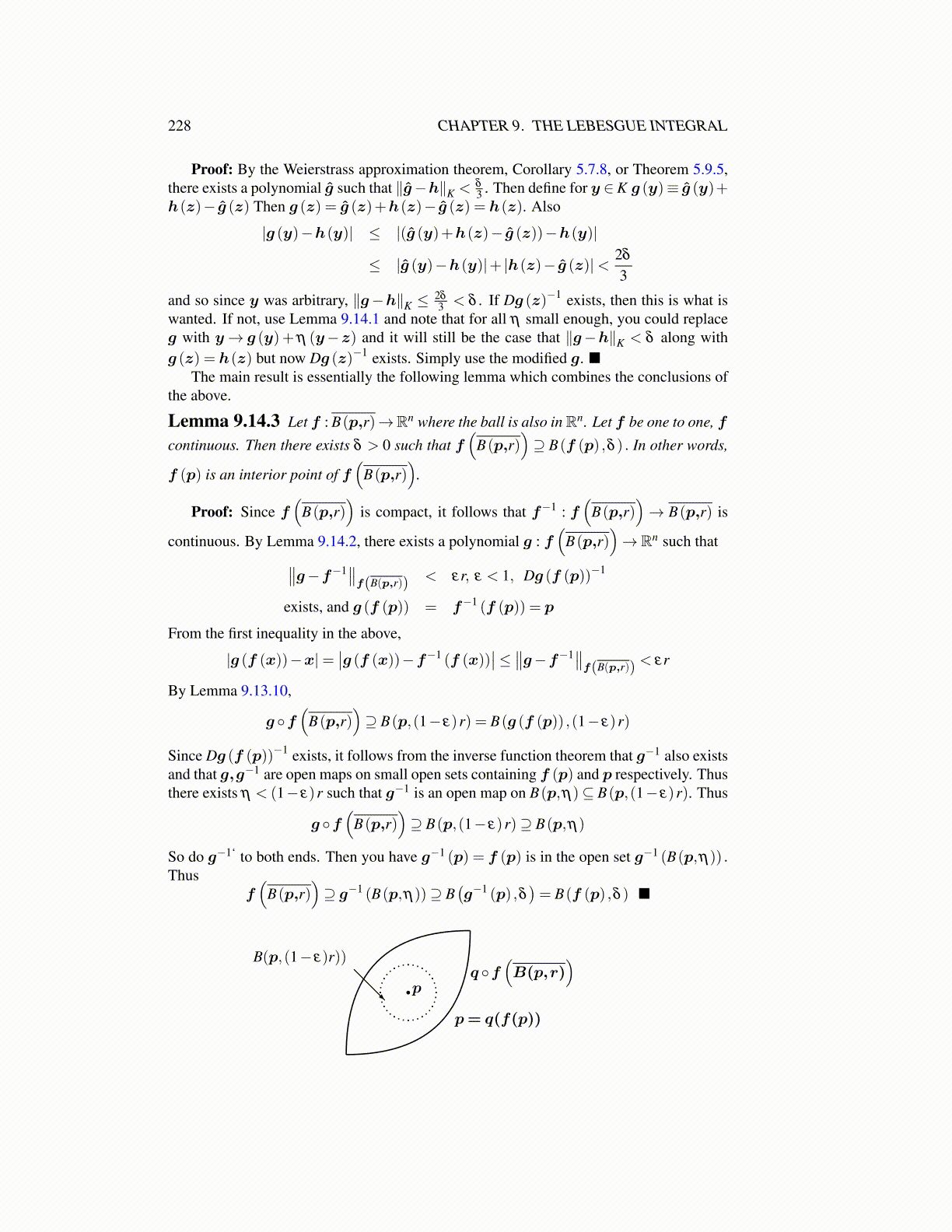
228 CHAPTER 9. THE LEBESGUE INTEGRAL
Proof: By the Weierstrass approximation theorem, Corollary 5.7.8, or Theorem 5.9.5,there exists a polynomial ĝ such that ∥ĝ−h∥K < δ
3 . Then define for y ∈K g (y)≡ ĝ (y)+h(z)− ĝ (z) Then g (z) = ĝ (z)+h(z)− ĝ (z) = h(z). Also
|g (y)−h(y)| ≤ |(ĝ (y)+h(z)− ĝ (z))−h(y)|
≤ |ĝ (y)−h(y)|+ |h(z)− ĝ (z)|< 2δ
3
and so since y was arbitrary, ∥g−h∥K ≤ 2δ
3 < δ . If Dg (z)−1 exists, then this is what iswanted. If not, use Lemma 9.14.1 and note that for all η small enough, you could replaceg with y→ g (y)+η (y−z) and it will still be the case that ∥g−h∥K < δ along withg (z) = h(z) but now Dg (z)−1 exists. Simply use the modified g. ■
The main result is essentially the following lemma which combines the conclusions ofthe above.
Lemma 9.14.3 Let f : B(p,r)→Rn where the ball is also inRn. Let f be one to one, f
continuous. Then there exists δ > 0 such that f(
B(p,r))⊇ B(f (p) ,δ ) . In other words,
f (p) is an interior point of f(
B(p,r))
.
Proof: Since f(
B(p,r))
is compact, it follows that f−1 : f(
B(p,r))→ B(p,r) is
continuous. By Lemma 9.14.2, there exists a polynomial g : f(
B(p,r))→ Rn such that∥∥g−f−1∥∥
f(B(p,r)) < εr, ε < 1, Dg (f (p))−1
exists, and g (f (p)) = f−1 (f (p)) = p
From the first inequality in the above,
|g (f (x))−x|=∣∣g (f (x))−f−1 (f (x))
∣∣≤ ∥∥g−f−1∥∥f(B(p,r)) < εr
By Lemma 9.13.10,
g ◦f(
B(p,r))⊇ B(p,(1− ε)r) = B(g (f (p)) ,(1− ε)r)
Since Dg (f (p))−1 exists, it follows from the inverse function theorem that g−1 also existsand that g,g−1 are open maps on small open sets containing f (p) and p respectively. Thusthere exists η < (1− ε)r such that g−1 is an open map on B(p,η)⊆ B(p,(1− ε)r). Thus
g ◦f(
B(p,r))⊇ B(p,(1− ε)r)⊇ B(p,η)
So do g−1‘ to both ends. Then you have g−1 (p) = f (p) is in the open set g−1 (B(p,η)) .Thus
f(
B(p,r))⊇ g−1 (B(p,η))⊇ B
(g−1 (p) ,δ
)= B(f (p) ,δ ) ■
pq ◦f
(B(p,r)
)B(p,(1− ε)r))
p= q(f(p))